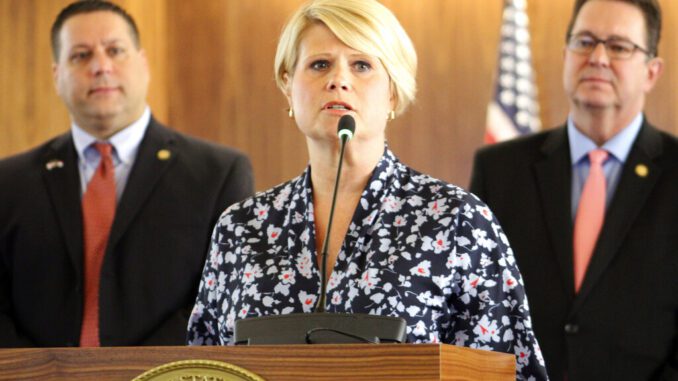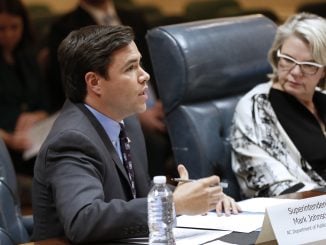
RALEIGH — Over the course of 2022, K-12 public education was marked by fights over required masking, continued protests over inappropriate materials, plummeting test scores, the flipping of school boards in the general election, and multiple movements to revamp state education policy.
Public education in North Carolina began 2022 with K-12 students as the only subset of the state’s population being forced to wear masks while in school. Parents and students alike had been pushing back on forced masking for months and, in February, North Carolina House Speaker Tim Moore (R-Kings Mountain) sent a letter to Democratic Gov. Roy Cooper asking for an end to the practices.
Legislation titled “Free the Smile Act” was passed in February by the General Assembly with bipartisan support, however, Cooper vetoed the measure. Cooper’s veto message said the bill was “passed for political purposes” and the public should not be able to “pick and choose” what health rules they follow. The bill would have given parents the ability to opt their child out of masking in school. An override attempt in the Senate fell short with two Democrats voting to uphold the veto who had originally voted to pass the bill.
Around the same time the legislature was trying to unmask students, Cooper began encouraging local government units and school districts to end masking mandates. The governor stopped short of issuing another executive order actually ending the practice.
On Feb. 25, the Centers for Disease Control and Prevention rolled out a new three-tiered “Community Levels” system which altered recommendations for masking. Most districts in North Carolina had already begun voting to end mask mandates by that time with 60 of the state’s 115 K-12 districts having ended the mandates as of Feb. 17.
It would not be until well after the end of the traditional K-12 school year that the N.C. Department of Health and Human Services would quietly sunset the “StrongSchools NC Public Health Toolkit” that districts had been following during the pandemic.
While the fight over masking had taken center stage, the N.C. Commission for Public Health was considering adding COVID-19 vaccinations to the required schedule of immunization for public education. The petition to add the shots was discussed and eventually unanimously denied.
Another fight that began in 2021 and spilled over into 2022 was the infusion of Critical Race Theory (CRT) in K-12 lessons. North State Journal found multiple districts across the state engaging in teacher training with CRT themes, the latest of which included Chatham County Public Schools. Meanwhile, it was uncovered that the new head of the Office of Equity Affairs in Wake County had given a presentation pushing social and racial justice in teaching high school mathematics.
The outcry by parents turned into a movement to flip local school board seats.
Republican candidates, many of which were parents, swept nearly half of all district school board races in the Nov. 8 election. A total of 83 out of the state’s 115 school districts had seats up for election. Per data compiled by EducationNC, 41 of the 83 were partisan races with 290 total seats up for grabs with 137 partisan seats being in partisan races. Republicans won 103 or 75% of the partisan race seats and Democrats won 34 or 25%. Republicans swept all seats in 21 of those 41 partisan races while Democrats only swept three.
In Wake County, the largest district in the state, five of the nine incumbents in didn’t seek reelection this November. Only two of the parent-led candidates were elected to the board in those races.
The previous board has seen a series of protests by parents with complaints including pandemic and mask policies, CRT, curriculum, transparency, and issues with the district’s Office of Equity Affairs, as well as vocal opposition to obscene books found in district libraries.
CRT was also taken up at the national level by two of North Carolina’s congressional delegation.
Rep. Dan Bishop (NC-09) introduced a resolution outlining the Marxist roots of the Critical Race Theory (CRT) and threat it poses to the United States while Rep. Virginia Foxx (NC-05) was one of 30 Republicans that sent letters to five federal departments questioning expenditures of COVID relief funds for CRT programs.
The pushback over CRT and other complaints by parents in 2021 had resulted in the targeting of those parents by President Biden’s Attorney General Merrick Garland, but it also spawned a bill to affirm parental rights and increase transparency with regard to their child’s education in both chambers of the North Carolina General Assembly. Both versions of the parental rights bill passed a first reading in their respective chambers but had almost no Democrat support. The measures eventually died after being referred to committees.
One area parents did gain a voice was with the Parent Advisory Commission formed by N.C. Superintendent Catherine Truitt.
“This Commission is focused on giving parents a seat at the table and strengthening parent and family involvement in education,” Truitt said in the press release accompanying the list of the 48 members selected for the commission.
Following the pandemic, school safety was also on the minds of most parents.
School safety reporting apps and state data had shown an uptick in school violence and threats. In Moore County, dozens of fights at a single middle school in the district were caught on video and posted to social media.
School safety as an issue has persisted into 2022 and this past fall the Department of Public Instruction’s (DPI) Center for Safer Schools awarded over $74 million in School Safety grants to 200 K-12 school districts across the state. The funds will be used for safety equipment, school resource officers, training and services for students in crisis in elementary, middle and charter schools across the state.
Funding for school safety wasn’t the only money talked about in K-12 education this year. The over 20 year old Leandro education funding case wound its way through the state’s legal system and landed in front of the N.C. Supreme Court.
In November, the Democrat majority on the state’s top court issued a ruling on Leandro just prior to the midterm elections that the minority opinion dubbed as “being about power.”
“Fundamentally, and contrary to what plaintiffs, executive branch defendants, and the majority would have the public believe, this case is not about North Carolina’s failure to afford its children with the opportunity to receive a sound basic education,” wrote Associate Justice Phil Berger, Jr. in the dissent. “The essence of this case is power — who has the power to craft educational policy and who has the authority to fund that policy.”
In the 4-3 decision, the Democratic majority sided with former Leandro Judge David Lee’s previous decision ordering three state entities — the state controller, state treasurer and the N.C. Office of Budget and Management — to transfer billions from the state’s coffers. The Leandro case now sits in the business court awaiting action.
Berger’s dissent focused on the state constitution’s appropriations clause which clearly states the legislature has the power of appropriations while underscoring the majority’s opinion undermines the court’s own past rulings in the case of Cooper v. Moore. Writing for the majority in that case, Associate Justice Sam Ervin affirmed the General Assembly has “exclusive” control of expenditures under the state’s appropriation clause.
In terms of education policy in the state, the state board of education along with Truitt and members of her agency have made slow but steady headway in revamping both teacher licensing and the state’s A-F school grading model.
An advisory group set up by DPI to revise the A-F model is still exploring ways to improve the model by adding more academic and nonacademic criteria.
On the licensure side, a request for a pilot program of the “Blueprint for Action plan” is headed to legislature per a decision made during state board of education meetings held on Nov. 30 and Dec. 1. The plan is a scaled-down of the November version approved by the Professional Educator Preparation and Standards Commission (PEPSC).
Academic achievement and learning loss were also hot topics in 2022.
The Office of Learning and Recovery (OLR) set up by Truitt issued findings showing K-12 academic achievement across the state fell behind by between two and 15 months across various subjects during remote learning imposed on students due to pandemic school closures. OLR’s findings were consistent with presentations on learning loss given to lawmakers by the Department of Public Instruction earlier in the year.
The September release of state testing data from the past school year also showed proficiency levels in all grade levels and content areas had not returned to pre-pandemic levels, save for NC Math 3. Proficiency rates overall rose from 45 percent in 2020-21 to 51 percent in 2021-22. The 2018-19 pre-pandemic proficiency rate was 59 percent.
The impact of learning loss was also seen on national tests.
“The national average score declines in mathematics for fourth- and eighth-graders were the largest ever recorded in that subject,” a press release by the National Assessment of Educational Progress (NAEP) stated.
NAEP math and reading scores in grades four and eight both dropped. Nationally, scores for fourth-graders fell eight points in math – the lowest in 20 years.
North Carolina’s results were not statistically different from the average national results, however, in math the state’s math scores dropped beyond the 20-year lows seen nationally.
Reading scores for North Carolina fourth and eighth graders fell five points and seven points respectively. The percentage of students scoring “below basic” achievement levels in reading hit a 15-year low of 39 percent for fourth-graders and eighth-graders came in at 34 percent; a percentage low last seen 17 years ago.
Scores on the ACT were the lowest in 30 years with the average ACT composite score coming in at 19.8 out of 36, marking the first time since 1991 that the average score was below 20. North Carolina’s composite score declined to 18.5 for 88 percent of those tested.
The State Board of Education saw a surprise resignation this year.
North State Journal broke the story in February that N.C. State Board of Education member Todd Chasteen had resigned, citing the controversial updates to the state’s Social Studies Standards passed in 2021 and a “trajectory away from education and towards activism” by the current board. Cooper quietly filled Chasteen’s vacancy with John M. Blackburn sometime in March.



